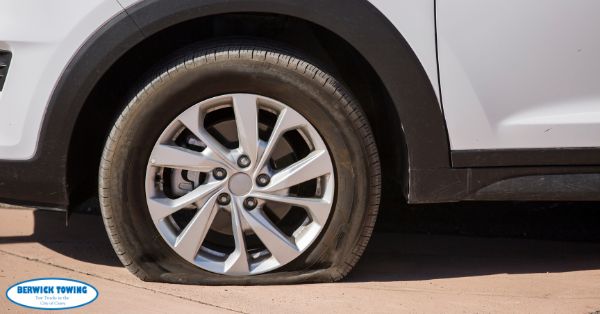Getting a flat tire is an unavoidable part of driving. Most people get flat tires when they least expect them to happen. It is worse when driving on highways because a flat tire could cause you to have an accident if when driving too fast. That is why you must know how to behave before, during, and after a flat tire situation.
It helps to take basic preventative actions to reduce the chances of getting a flat tire. First, check the air pressure in all four tires to ensure it matches the manufacturer’s PSI recommendations (find the PSI for your tire). If you notice that your tires have low air pressure, you’ll need to fill the tires with air. We recommend you buy an air compressor and perform this action at home. Air compressors don’t cost much at all; otherwise, you do that at most local gas stations.
Another preventative action is to inspect your tires for signs of damage, such as cracks, worn treads, or nails stuck in the rubber. If you notice any of these signs, you should repair the damage or replace the tires immediately. A professional will be able to tell whether a repair or replacement is required.
Most people operate front-wheel drive vehicles. Each time you brake or turn the steering wheel, it adds wear and tear to the front tires. The additional stress placed on the two front tires will cause them to wear down faster. That is why you should pay closer attention to your two front tires because they will likely need replacement sooner than your rear tires.
Any good mechanic will tell you to perform tire rotations periodically. That way, the wear and tear of the treads will get evenly distributed to each tire. You can get your tires rotated at the same time you get your oil changed. It is a cheap procedure and could significantly reduce the stress placed on your tires.
How to Handle a Flat Tire
Of course, all these preventative actions won’t guarantee anything. You could still get a flat tire from something entirely out of your control. When a flat tire happens, your number one goal should be to replace the tire. Let’s explore the best ways to get this done.
Below are the top six steps of handling a flat tire situation.
1. Pull Over
When a tire goes flat as you drive, you will immediately hear a loud grinding noise coming from underneath your vehicle. You’ll also notice that steering the car will become increasingly difficult too. An emergency light will turn on your dashboard if you drive a newer model.
Don’t drive for too long under these conditions. Slow down and turn on your emergency lights to let other drivers know you are in trouble. Now look for a clear space on the side of the road and slowly pull into it.
Park the vehicle in a safe location away from traffic so that you have room to work around the vehicle. Then, activate the emergency brake to keep your car stable and secure.
2. Loosen the Lug Nuts
Every vehicle comes equipped with a lug wrench. Grab your lug wrench from the trunk and locate the flat tire on the side of the car. Loosen its lug nuts with the wrench once you see which tire is flat. You’ll have to turn the wrench in a counterclockwise direction to loosen them. Make sure you do this BEFORE using the jack.
3. Position the Jack
Grab the jack (what is a jack and how to use it) from the rear trunk. Locate the little grooves on the side of your vehicle near the flat tire. These grooves indicate where the jack is supposed to get placed underneath. Position the jack underneath the side and rotate the handle to lift the vehicle. Keep turning the handle until you see the flat tire lifted entirely off the ground.
4. Remove the Flat Tire
Remove the loosened lug nuts. Now remove the flat tire by pulling it toward your direction. Once the tire gets removed, take out the spare tire from the trunk. The flat tire can get stored in the trunk for the time being.
5. Install the Spare Tire
Lift the spare tire and slide the holes of the tire rim through the lug bolts. Make sure they are all aligned perfectly. Now reinstall the lug nuts onto the lug bolts until they are tight. Rotate the lug wrench in a clockwise direction this time to install the nuts. At this point, your spare tire should be securely installed.
6. Lower the Vehicle
Use the jack to lower the side of the vehicle back down until the spare tire is on the ground entirely. Store the lug wrench and jack in the trunk.
7. Visit a local tire shop to replace the flat and install it instead of the spare.
Conclusion
Always remember to keep a spare tire or donut tire in the trunk of your car. It can save you so much time and expense because you won’t have to tow your vehicle or carry the tire to an auto shop. Instead, you can replace the flat tire with the spare and drive your vehicle to the auto shop as needed. That is the ideal situation you will want to have for yourself.
How to replace a flat:
-
Pullover!
-
Loosen the nut lug
-
Position the jack
-
Remove the flat
-
Install the spare
-
Lower the vehicle
-
Store the flat in the truck
Affordable Towing Services Company in Melbourne South Eastern Suburbs.
Berwick Towing & Transport located near the 29 Blaxland Dr, Dandenong North VIC 3175 Please check below map.
Berwick Towing & Transport
27B William Rd
Berwick VIC 3806
https://berwick-towing.com.au/
* Find us on Google Map

